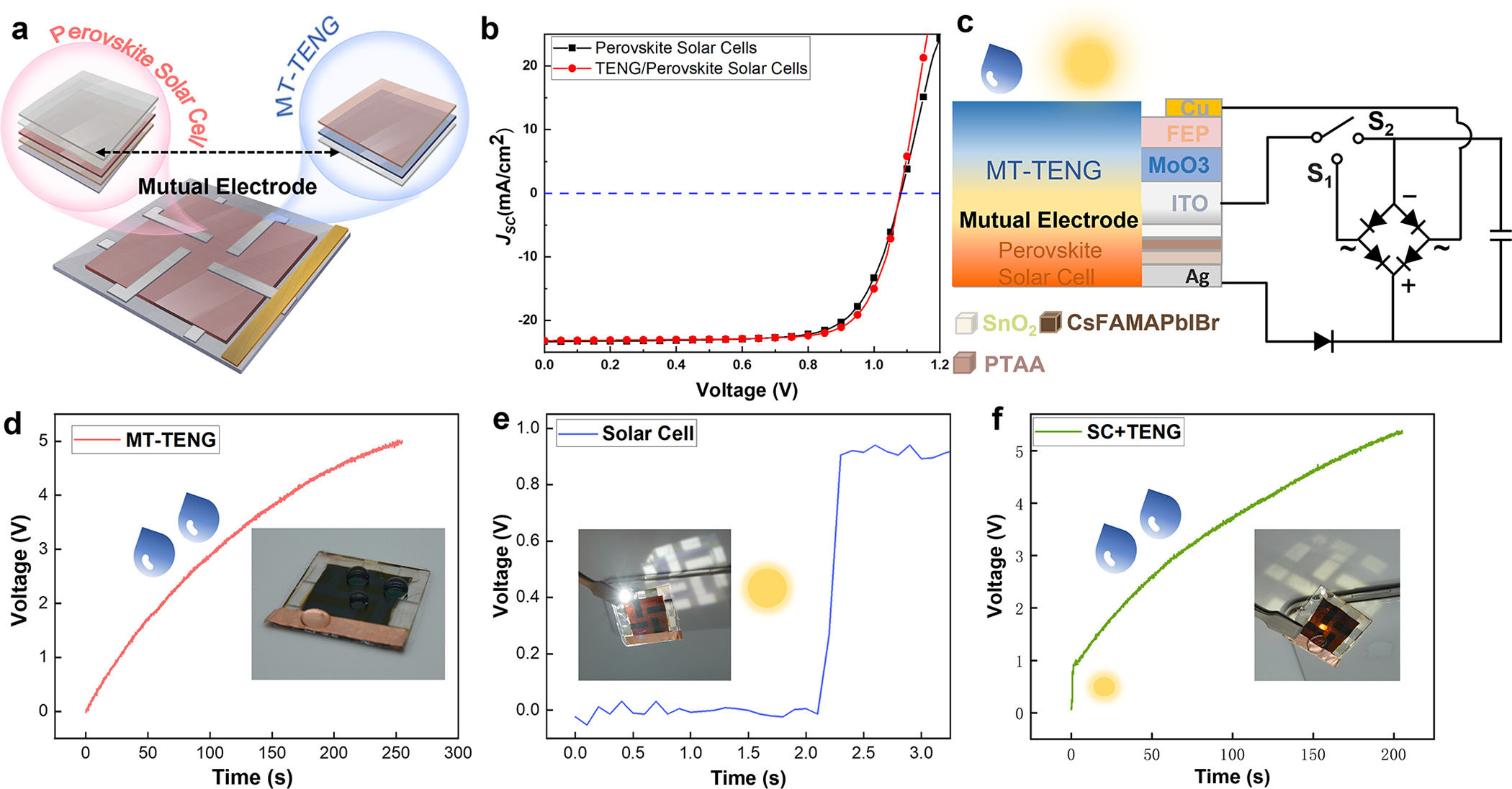| Mar 24, 2022 |
Solar cell also generates electricity from raindrops on rainy days
(Nanowerk News) Researchers have developed a new approach for making an all-weather solar cell that is triggered by both sunlight and falling raindrops. They designed a a raindrop solar cell by integrating a triboelectric nanogenerator (TENG) and perovskite solar cells to harvest raindrop energy and solar energy efficiently to provide a distributed energy source.
|
|
Triboelectric nanogenerators use a combination of the triboelectric effect and electrostatic induction to generate small amounts of electrical power from mechanical energy such as rotation, sliding, vibration or as in this case, the impact of falling raindrops. The triboelectric effect takes advantage of the fact that certain materials become electrically charged after they come into moving contact with a surface made from a different material.
|
|
Developed over the past several years, TENG technology has advanced to the point where it can power small electronic devices, potentially enabling widespread sensing and infrastructure systems as well as powering wearable consumer devices.
|
|
So far, there have been several raindrop solar cells designs, all of them silicon solar cells. However, compared to the output power of solar cells, the energy conversion of the rainwater harvesting devices has been very small, so it often has been ignored.
|
|
In order to boost the power generation of rainwater by magnitudes, researchers have developed a new approach to make raindrop solar cells of practical use. They report their findings in ACS Nano ("Interface Engineering for Efficient Raindrop Solar Cell").
|
|
To construct an effective raindrop solar cell adequate for not only enhancing the water droplet energy harvesting but also avoiding the reduction of solar cell performance, the researchers designed an architecture that integrates a MoO3/top electrode-based TENG (MT-TENG) and perovskite solar cells.
|
 |
| Demonstration of the raindrop solar cell with harvesting energy from raindrops’ mechanical energy and solar energy. (a) Schematic illustration of the raindrop solar cell. (b) J−V curves of the bare perovskite solar cell and the solar cell with the MT-TENG under the illumination of simulated AM 1.5G (100 mW/cm2) solar spectra. (c) Circuit diagram of the raindrop solar cell connecting by a mutual electrode. Charging a 2.2 µF capacitor with (d) the MT-TENG only, (e) a perovskite solar cell only, and (f) a mutual electrode based raindrop solar cell (the insets show profile displays of the devices in different working conditions). (Reprinted with permission by American Chemical Society) (click on image to enlarge)
|
|
The researchers inserted the MoO3 electron blocking layer in a transparent indium tin oxide (ITO) electrode and fluorinated ethylene propylene (FEP) polymer triboelectric layer, constructing the MT-TENG, which avoids the charge-shielding effect between the interfaces and polarizes FEP to increase and keep the charge captured.
|
|
Introducing this concept of the electron blocking layer into the TENG at the solid−liquid interface improves the efficiency of harvesting raindrop energy. As the team points out, the interlayer design enables every water droplet to generate a colossal electrical output.
|
|
In addition, the MT-TENG is attached to the entire perovskite solar cell by a shared electrode, which hardly affects the photovoltaic power conversion efficiency of the solar cell.
|
|
Using dripping tap water to simulate raindrops falling on the MT-TENG, the researchers measured a maximum output electrical power of 0.67 mW obtained at 1 MΩ.
|
|
Although the output loss (0.33 W/m2) of solar cells cannot be ignored, the average output power of the MT-TENG (0.568 W/m2) is far greater than the loss of the solar cell, which proves the rationality of constructing a raindrop solar cell.
|

 By
Michael
Berger
– Michael is author of three books by the Royal Society of Chemistry:
Nano-Society: Pushing the Boundaries of Technology,
Nanotechnology: The Future is Tiny, and
Nanoengineering: The Skills and Tools Making Technology Invisible
Copyright ©
Nanowerk LLC
By
Michael
Berger
– Michael is author of three books by the Royal Society of Chemistry:
Nano-Society: Pushing the Boundaries of Technology,
Nanotechnology: The Future is Tiny, and
Nanoengineering: The Skills and Tools Making Technology Invisible
Copyright ©
Nanowerk LLC
